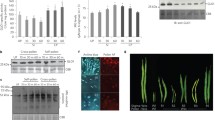Abstract.
As part of the Brassicaceae self-incompatibility response, callose is deposited in the stigma papillar cells. To determine if callose plays an important role in the rejection of incompatible pollen by the stigma, transgenic Brassica napus. L. plants were produced which express the tobacco β-1,3-glucanase cDNA (the enzyme which degrades callose) in the stigma papillae. Using aniline blue fluorescence, little or no callose was detected in the papillar cells of transgenic stigmas. However, the self-incompatibility system appeared to be unaffected based on the lack of pollen tube growth and the subsequent lack of seed set. The transgene had no effect on compatible pollinations. Thus, while callose deposition is associated with the B. napus self-incompatibility response, it is not required for the rejection of incompatible pollen.
Similar content being viewed by others
Author information
Authors and Affiliations
Additional information
Received: 14 March 1997 / Accepted: 15 April 1997
Rights and permissions
About this article
Cite this article
Sulaman, W., Arnoldo, M., Yu, K. et al. Loss of callose in the stigma papillae does not affect the Brassica self-incompatibility phenotype. Planta 203, 327–331 (1997). https://doi.org/10.1007/s004250050198
Issue Date:
DOI: https://doi.org/10.1007/s004250050198




